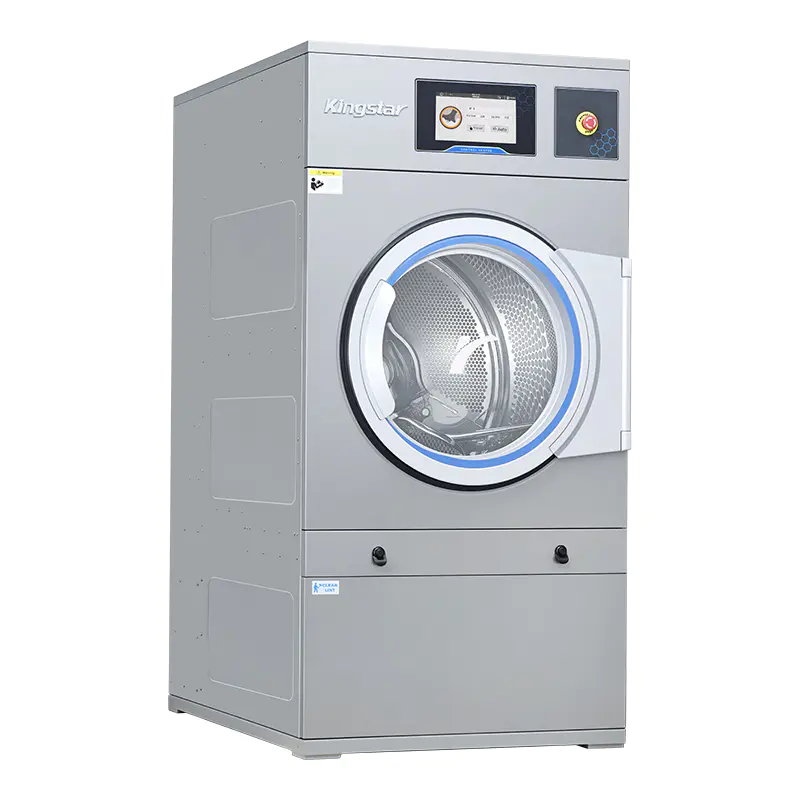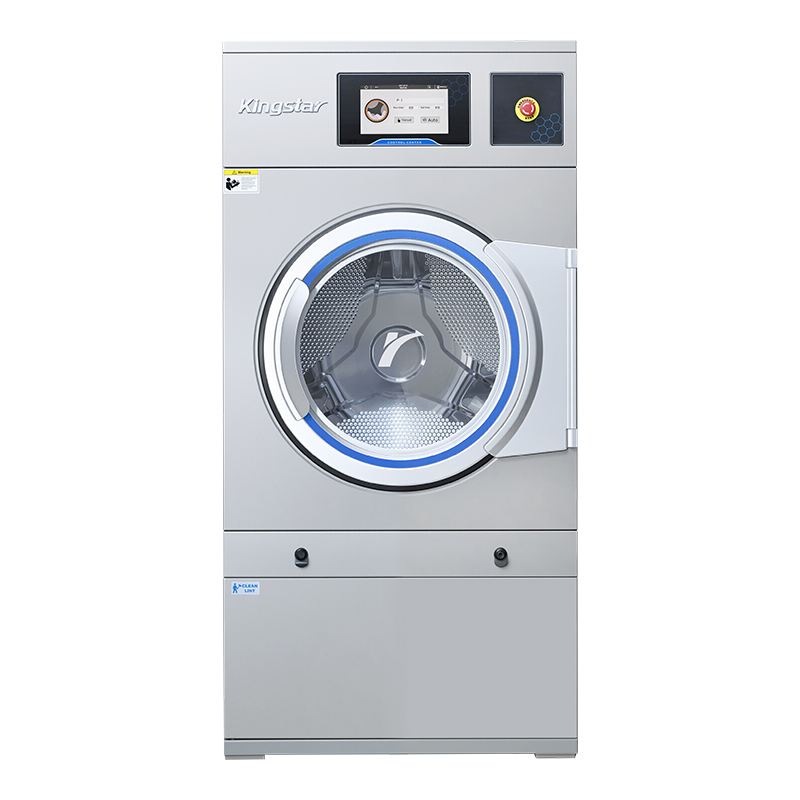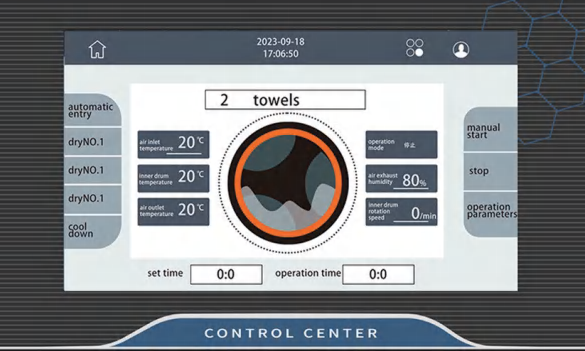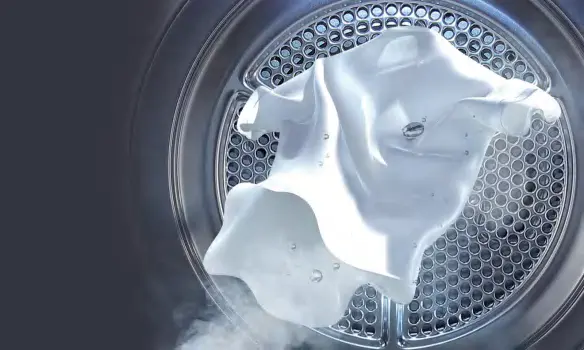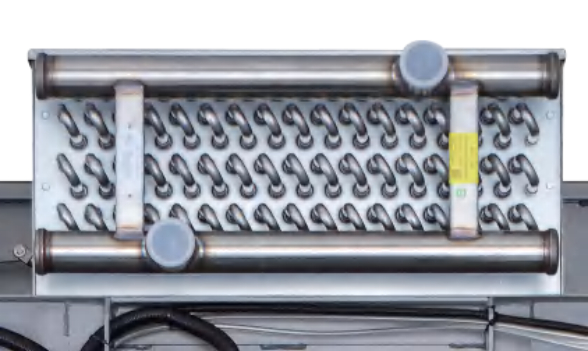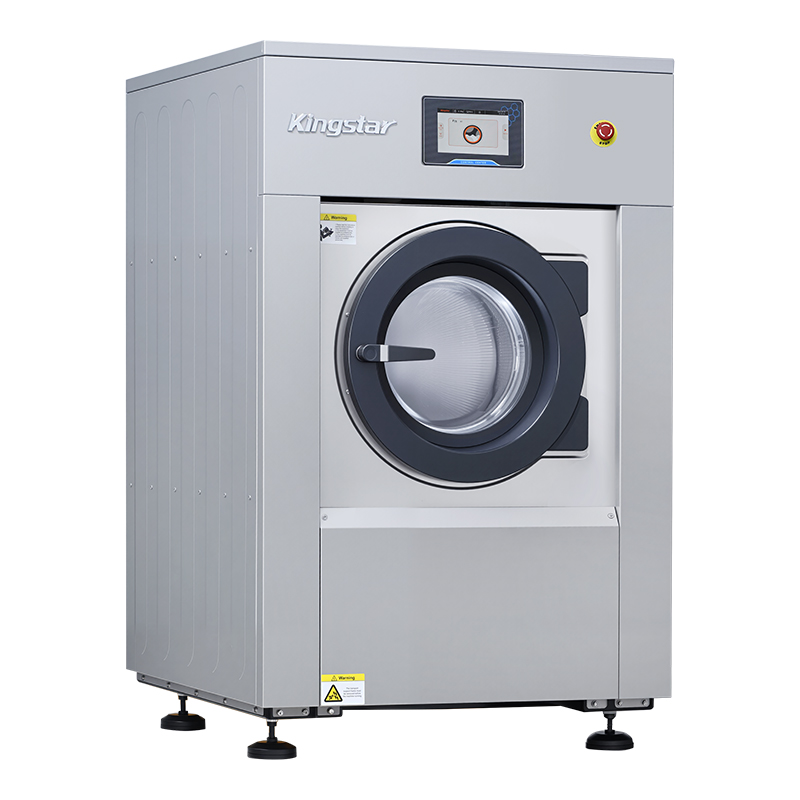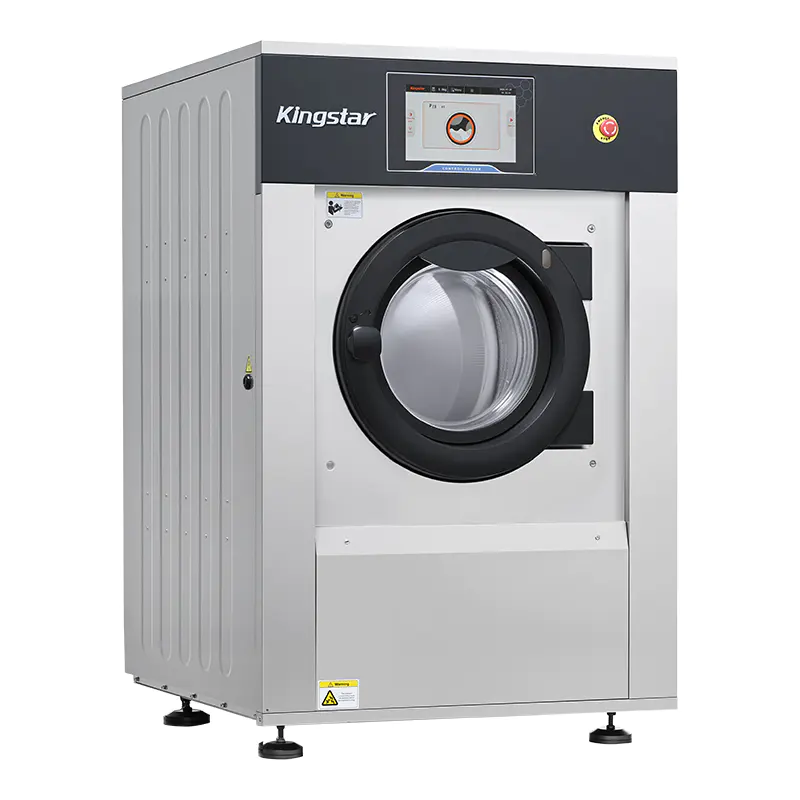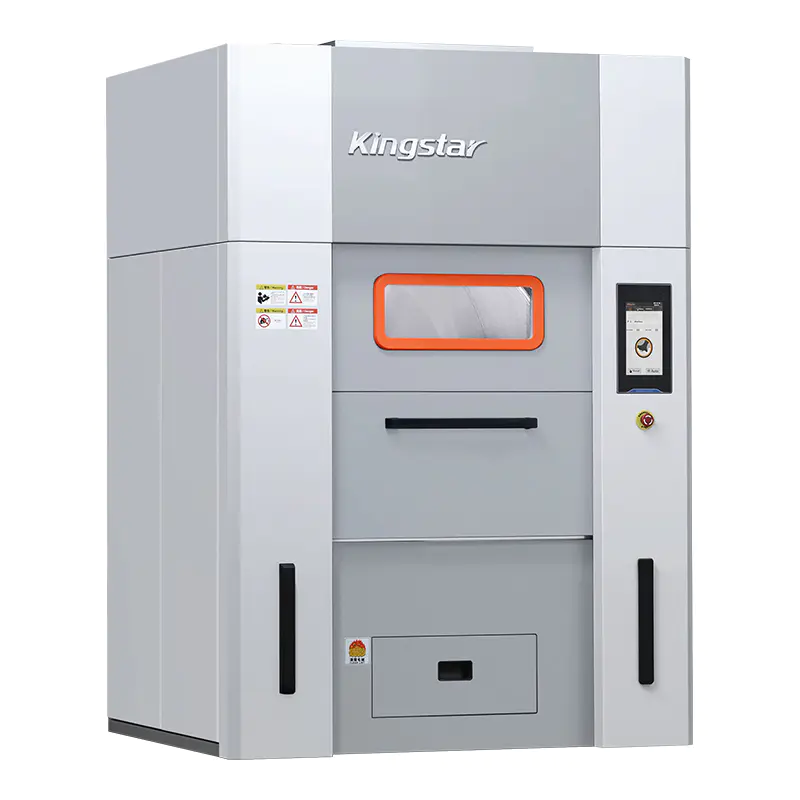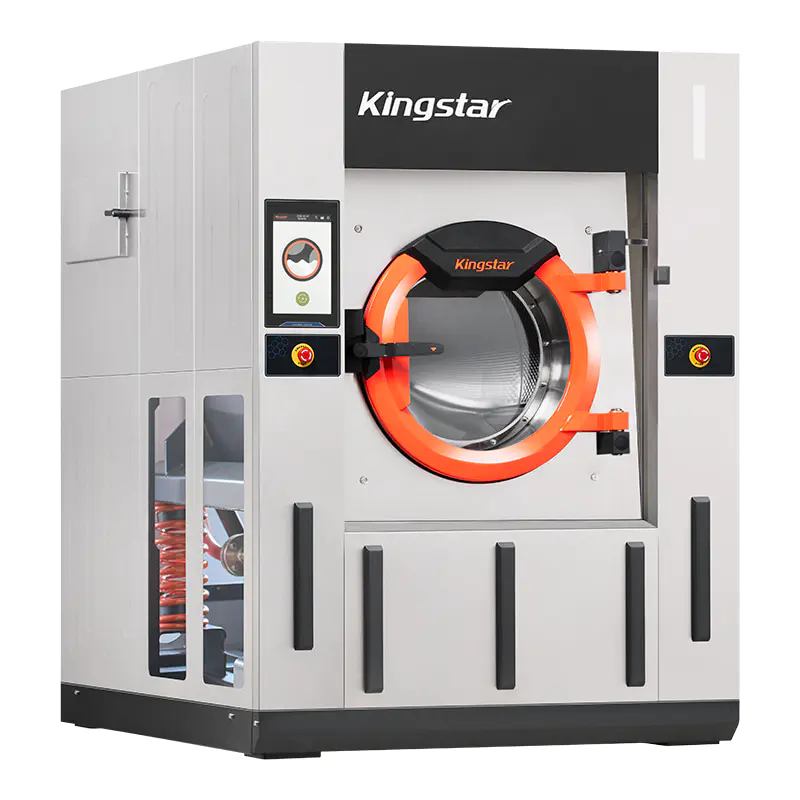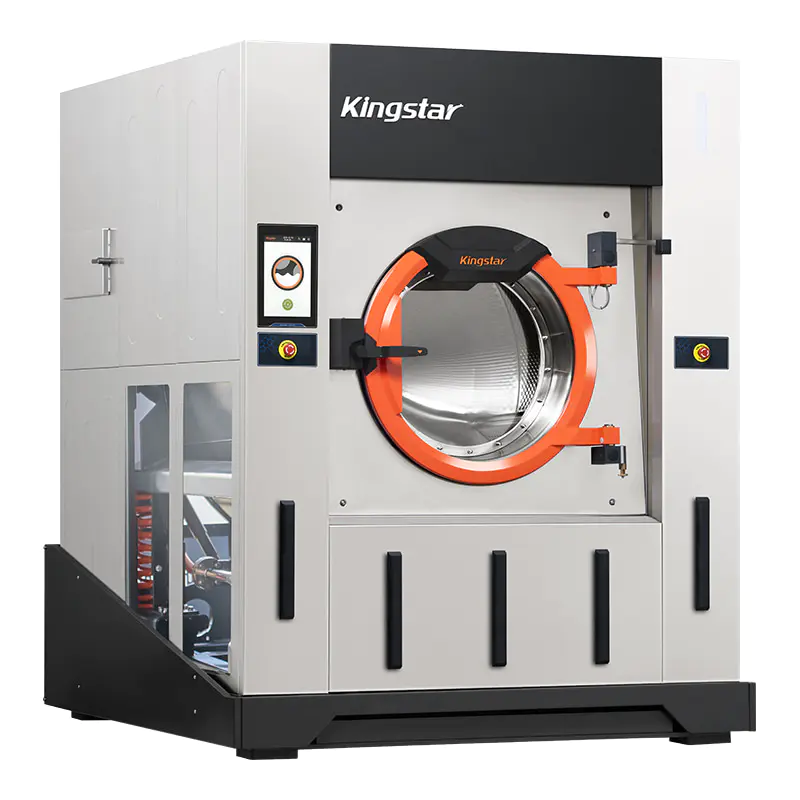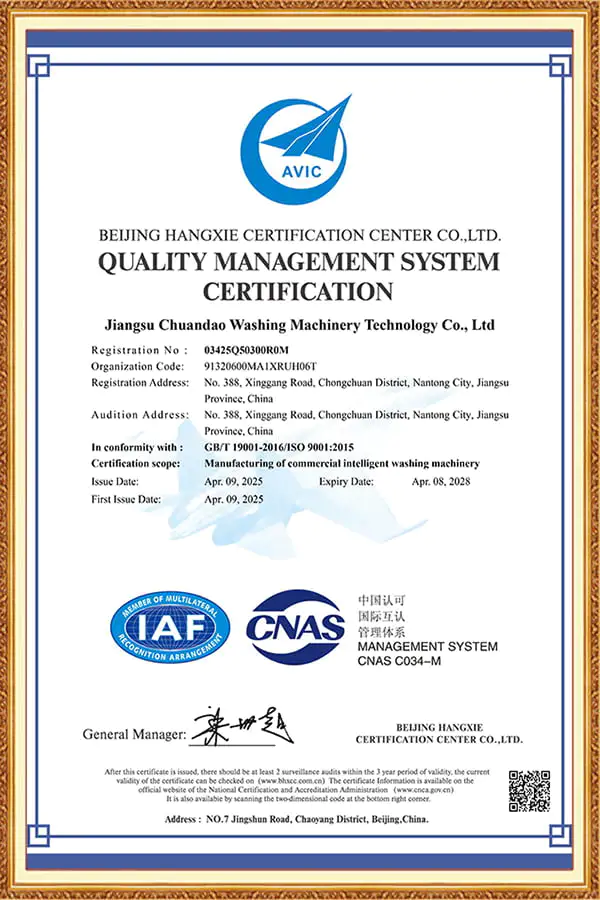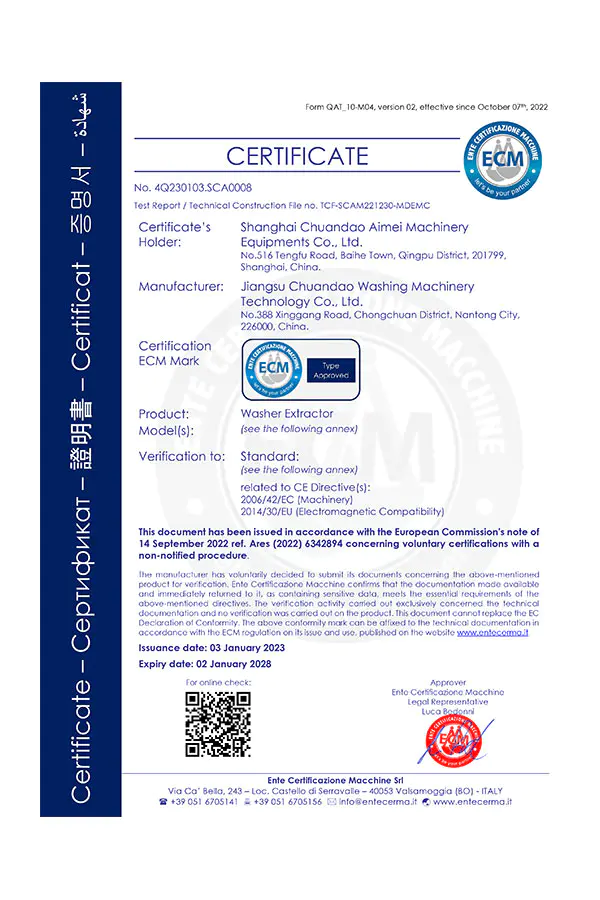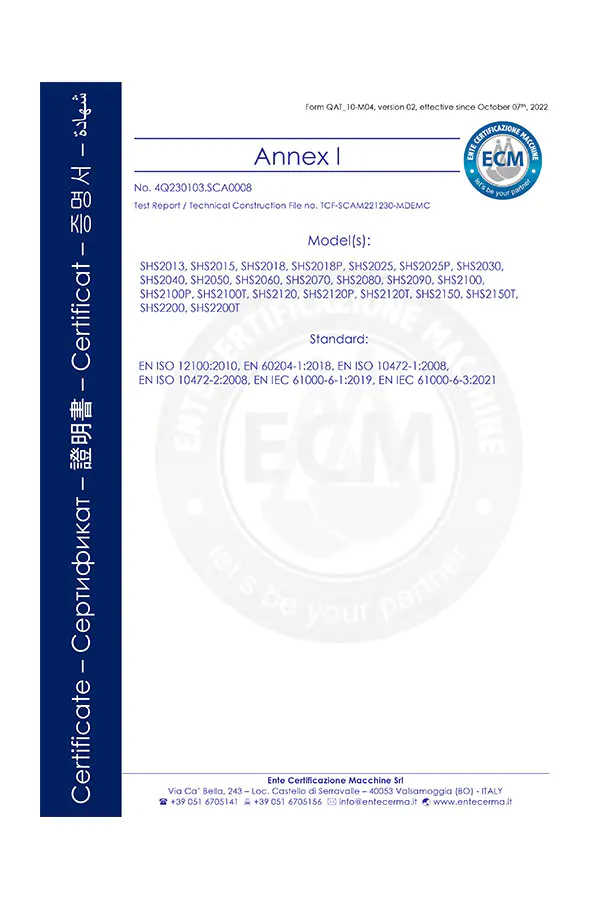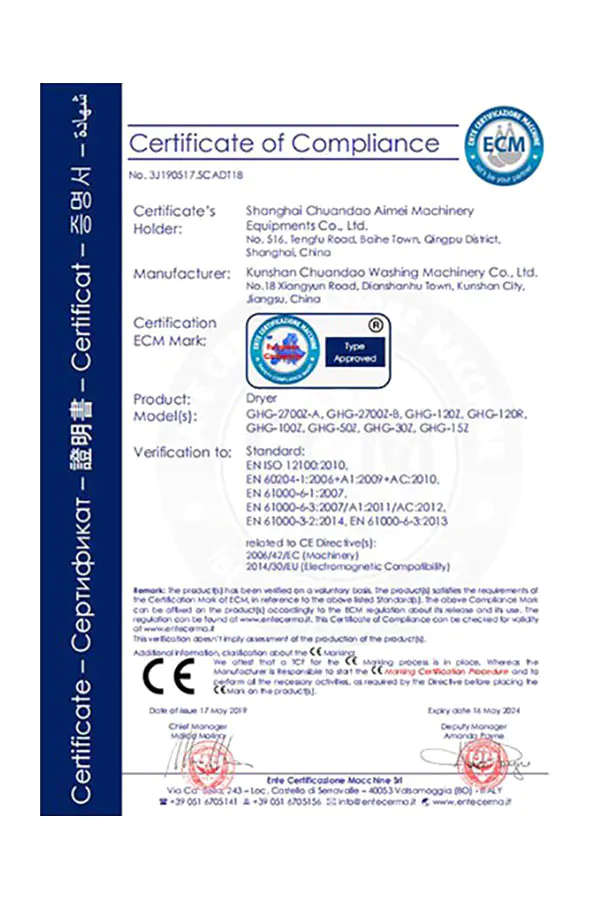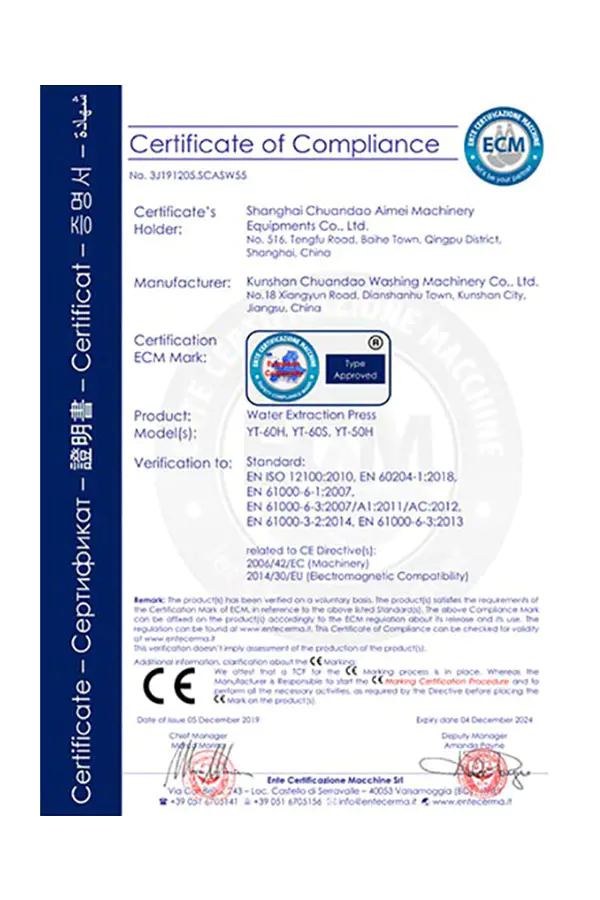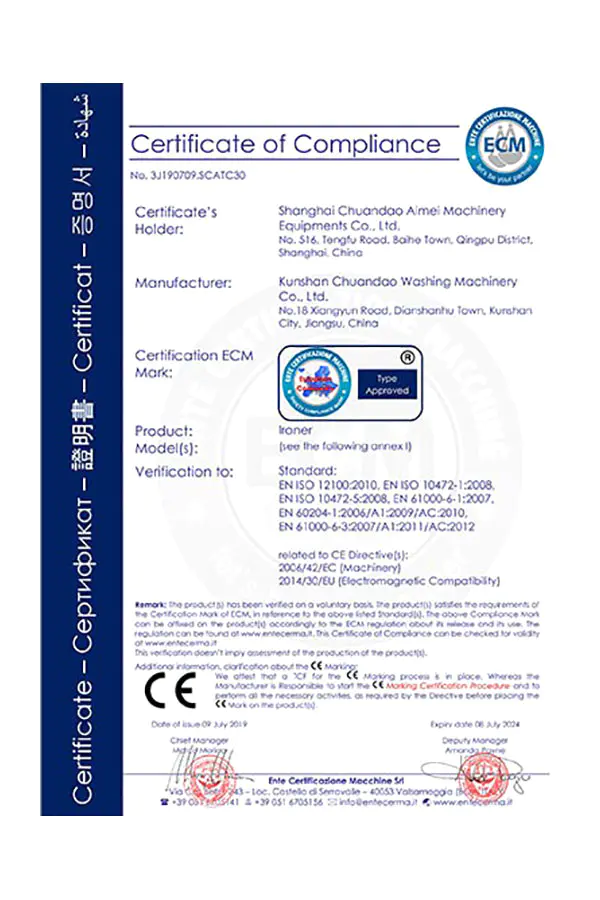Commercial Dryer
Introducing the latest innovation in industrial drying technology-Commercial Dryer. This high-performance industrial dryer is designed to meet the stringent requirements of commercial and industrial laundry facilities. With its advanced features and cutting-edge technology, this dryer delivers unparalleled efficiency and performance.
-

Laundry
-

Dry cleaner
-

Self-service
laundry
- 15kg
- 20kg
- 25kg
(86)+86-13917089379
-

① Advanced Intelligent Drying System
Equipped with a 10-inch full-color HD touchscreen, it includes 99 built-in editable automatic programs, allowing selection based on different clothes and linens. -

② Loading Capacity Design
Designed with a 1:18 loading capacity ratio, the inner drum is made of 304 stainless steel material with a large door design, making it convenient for loading and unloading clothes. -

③ High-Power Heating Design
Features a high-power heating system with an added insulation layer on the outer cylinder, ensuring quick temperature rise, good insulation effect, and improved drying efficiency. -

④ Imported Electrical Components
All electrical components are imported brands, including Mitsubishi inverters, Schneider contactors, and all wires plugs, and bearings are also imported brands. -

⑤ Multiple Heating Methods
Offers three heating methods: steam heating, electric heating, and gas heating.
-
 Simple operation
Simple operation -
 Intelligentize
Intelligentize -
 Humanized design
Humanized design -
 High quality
High quality
|
Specification Model |
SDR-2015 |
SDR-2020 |
SDR-2025 |
|
Drum Diameter(mm) |
750 |
850 |
850 |
|
Drum Depth(mm) |
680 |
640 |
800 |
|
VOLUME(L) |
300 |
400 |
453 |
|
VOLUME Load Ratio |
1:20 |
1:20 |
18 |
|
Main Motor Power(KW) |
0.37 |
0.55 |
0.75 |
|
Fan Motor Power(KW) |
0.37 |
0.55 |
0.55 |
|
Rated Voltage(v) |
380 |
380 |
380 |
|
Heater Power(KW) |
13.5 |
18 |
22.5 |
|
Steam Pressure(MPa) |
0.6 |
0.6 |
0.6 |
|
Width(mm) |
850 |
900 |
890 |
|
Depth(mm) |
1200 |
1200 |
1420 |
|
Height(mm) |
1600 |
1700 |
1805 |
|
Weight(KG) |
220 |
250 |
500 |
About us
Craftsman spirit, excellence, quality products are the bridge to the world!
Jiangsu Chuandao Washing Machinery Technology Co., Ltd. is a professional China Commercial Dryer Suppliers and Commercial Dryer Manufacturers. Shanghai Chuandao was established in March 2001, Kunshan Chuandao was established in May 2010, and Jiangsu Chuandao was established in February 2019. Now the total area of Chuandao enterprise is 130,000 square meters and the total construction area is 100,000 square meters. After nearly 20 years of development, CLM has grown into a leading enterprise in China's laundry industry.
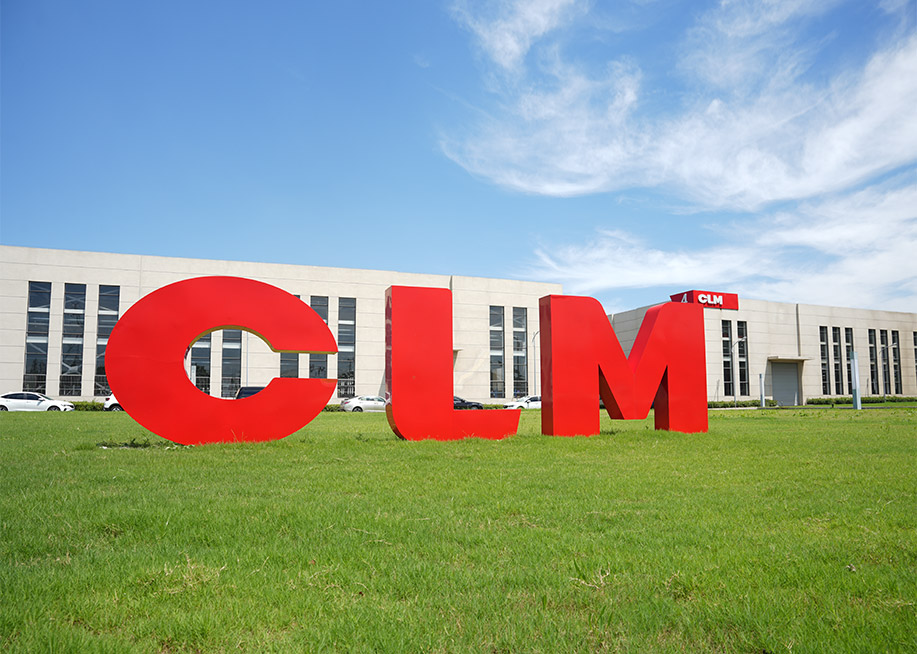
Honor & Qualification
Choose comes from trust, and cooperation
comes from honesty.
NEWS
What is a commercial dryer and how is it different from a household dryer?
Definition of a Commercial Dryer
A commercial dryer is a large-scale machine designed for drying significant quantities of textiles such as clothing, bedding, towels, or uniforms in commercial or industrial environments. These machines are engineered for frequent and continuous use, providing higher durability, greater load capacity, and enhanced efficiency compared to household dryers. Commercial dryers are commonly found in laundromats, hotels, hospitals, manufacturing facilities, and institutions where large amounts of laundry need to be processed daily. Their design emphasizes longevity, serviceability, and consistent performance under heavy workloads.
Definition of a Household Dryer
A household dryer, also known as a residential dryer, is a machine intended for personal or family use within a domestic setting. It is typically designed to handle smaller loads and operates at lower capacity compared to commercial units. Household dryers focus on user-friendly controls, compact size, and integration with home environments. They are sufficient for regular household laundry needs, such as drying clothes, linens, and small textiles. While effective for home use, household dryers are not built to sustain continuous operation or heavy-duty usage typical in commercial environments.
Capacity Differences
One of the most obvious differences between commercial and household dryers is their capacity. Commercial dryers can handle significantly larger loads, sometimes exceeding 20–30 kilograms per cycle, depending on the model. This allows businesses or institutions to process large volumes of laundry quickly, reducing the number of cycles needed. Household dryers, on the other hand, generally have a capacity between 6–10 kilograms, which is sufficient for typical family laundry but not for bulk operations. The higher capacity of commercial dryers directly supports productivity in professional laundry services.
Durability and Construction
Commercial dryers are constructed with heavy-duty materials such as reinforced steel drums, industrial-grade motors, and high-quality bearings. These components are designed to withstand constant use throughout the day and handle heavy textile loads. Household dryers, while well-built for personal use, typically employ lighter materials and components tailored for less frequent operation. This difference in construction results in commercial dryers having a longer service life when used in demanding environments, while household dryers may wear out faster if exposed to similar usage.
Energy Consumption Characteristics
Energy consumption varies greatly between commercial and household dryers. Commercial dryers consume more power due to their size, capacity, and heating requirements, but they are often designed with energy efficiency in mind to reduce operating costs for businesses. Household dryers use less energy per cycle but may require multiple cycles for larger laundry loads, which can offset their apparent energy efficiency. The difference is not only in total energy use but also in how each type of dryer manages energy relative to workload.
| Type of Dryer | Average Load Capacity | Energy Use per Cycle | Typical Application |
|---|---|---|---|
| Commercial Dryer | 20–30 kg+ | 5–12 kWh | Laundromats, hotels, hospitals |
| Household Dryer | 6–10 kg | 2–4 kWh | Domestic laundry needs |
Cycle Time and Efficiency
Commercial dryers are designed to complete cycles more quickly than household dryers, allowing multiple loads to be processed in a shorter amount of time. This efficiency is critical in business settings where turnaround speed directly affects operations and customer satisfaction. Household dryers, while effective, often take longer to dry larger loads and are optimized for smaller, less urgent tasks. Faster drying cycles in commercial machines are achieved through stronger airflow, more powerful heating elements, and optimized drum designs.
Control Systems and Features
The control systems in commercial dryers are often more advanced, offering programmable cycles, multiple heat settings, and digital monitoring systems that can be customized to different fabric types and load requirements. Some models include diagnostic tools to simplify maintenance. Household dryers, however, prioritize simplicity and user-friendliness, typically offering a smaller selection of settings designed for common laundry types. While convenient for home users, these controls do not provide the flexibility or precision required in commercial settings.
Installation Requirements
Commercial dryers often require specialized installation, including higher voltage electrical connections, larger exhaust systems, and sometimes gas connections for gas-powered models. These requirements ensure the machines can operate safely and efficiently at high capacities. Household dryers, on the other hand, are designed to be installed in standard residential environments, usually requiring only basic electrical outlets and smaller venting systems. The difference in installation needs underscores the different environments each type of dryer is designed for.
Maintenance and Serviceability
Maintenance needs differ significantly between commercial and household dryers. Commercial units are designed with easy serviceability in mind, allowing technicians to quickly access parts for repair or replacement. This reduces downtime in business operations. Household dryers, while requiring maintenance such as lint filter cleaning and occasional servicing, are not engineered for rapid part replacement or frequent servicing. If household dryers are subjected to heavy use, they may require more frequent repairs compared to commercial dryers.
Cost Differences
The cost of commercial dryers is substantially higher than that of household dryers. This includes both initial purchase price and ongoing operational expenses such as energy and maintenance. The higher cost of commercial dryers reflects their capacity, durability, and performance in professional environments. Household dryers are more affordable and designed to meet the needs of families or individuals. Businesses often view the investment in commercial dryers as necessary to support operations, whereas household dryers are purchased with affordability and convenience in mind.
Applications of Commercial Dryers
Commercial dryers are used in a variety of sectors. Laundromats rely on them to serve multiple customers simultaneously, ensuring quick service. Hotels and resorts use them to process large quantities of bedding and towels daily. Hospitals depend on them for hygienic and fast drying of linens and uniforms. Manufacturing facilities that require textile processing also employ commercial dryers. These diverse applications highlight the role of commercial dryers in supporting large-scale laundry operations across industries.
Applications of Household Dryers
Household dryers are designed for personal laundry needs within homes. They are used to dry clothes, bedding, and towels on a regular basis, supporting the laundry requirements of individuals and families. Household dryers are not suitable for handling industrial-level laundry loads but provide convenience and reliability for daily use. Their smaller size and compatibility with domestic electrical systems make them well-suited for residential environments.
Environmental Considerations
Both commercial and household dryers have environmental impacts related to energy use and emissions. Commercial dryers, due to their higher power demand, have a larger carbon footprint per cycle but often integrate energy-saving technologies such as moisture sensors and heat recovery systems. Household dryers consume less energy per cycle but may not include advanced efficiency features found in commercial models. Users of both types of dryers are increasingly considering energy ratings and sustainability features when making purchasing decisions.
Noise Levels
Noise levels differ between the two dryer types. Commercial dryers tend to be noisier due to their larger motors, stronger airflow, and higher operational capacity. However, since they are used in designated laundry rooms or commercial facilities, noise is less of a concern. Household dryers are generally quieter, designed to operate in close proximity to living spaces. This distinction reflects the environments in which each type of dryer is typically installed.
Technology Integration
Recent advancements have introduced smart technologies into both commercial and household dryers. Commercial dryers may be connected to centralized monitoring systems in laundromats, allowing operators to track usage, performance, and energy consumption. Household dryers often feature smart home integration, enabling users to control cycles via mobile apps or receive notifications when laundry is complete. While the core purpose of both machines remains the same, technology integration has expanded their functionality and convenience.
Comparison of Key Features
The following table summarizes major differences between commercial and household dryers in terms of functionality, capacity, and intended usage:
| Feature | Commercial Dryer | Household Dryer |
|---|---|---|
| Load Capacity | 20–30 kg+ | 6–10 kg |
| Durability | Heavy-duty, long-term use | Standard domestic use |
| Energy Consumption | 5–12 kWh per cycle | 2–4 kWh per cycle |
| Cycle Duration | Shorter, high-efficiency cycles | Longer, optimized for smaller loads |
| Cost | Higher purchase and operating costs | Lower purchase cost, affordable operation |
| Installation | Specialized electrical and venting systems | Standard residential connections |
| Applications | Laundromats, hotels, hospitals, institutions | Homes, personal laundry needs |
Longevity and Lifecycle
Commercial dryers typically have a longer operational lifecycle when used as intended, often lasting for many years even under constant heavy loads. They are built for intensive operation and can be refurbished or upgraded for extended use. Household dryers have a shorter lifecycle when compared directly, as they are not meant for industrial-scale use. However, in domestic environments with moderate laundry needs, household dryers can last for a decade or more with proper maintenance. The difference in lifecycle reflects the environments each machine is designed to support.
User Experience and Accessibility
Commercial dryers are designed with professional operators in mind, providing robust features, programmable controls, and durable construction. They may not always prioritize ease of use for untrained individuals, as they are primarily installed in environments where staff or customers are familiar with operating laundry machines. Household dryers, in contrast, prioritize accessibility, ease of operation, and safety features suitable for all family members. This difference reflects the target audience of each type of dryer.

 English
English русский
русский Español
Español